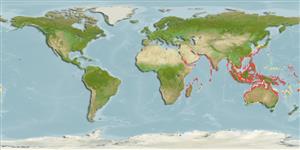>
Eupercaria/misc (Various families in series Eupercaria) >
Lutjanidae (Snappers) > Lutjaninae
Etymology: Lutjanus: Malay, ikan lutjan, name of a fish.
More on author: Bloch.
Environment: milieu / climate zone / depth range / distribution range
Ecologie
marien rifbewoner; diepte 10 - 30 m (Ref. 9710). Tropical
Indo-West Pacific: widespread; from South Africa to the Philippines; north to Japan. Records from the Middle East, including the Red Sea, refer to L. sapphirolineatus.
Grootte / Gewicht / Leeftijd
Maturity: Lm ? range ? - ? cm
Max length : 30.0 cm TL mannelijk / geslacht onbekend; (Ref. 55); common length : 20.0 cm TL mannelijk / geslacht onbekend; (Ref. 55)
Dorsale stekels (totaal) : 11; Dorsale zachte stralen (totaal) : 13 - 14; Anale stekels: 3; Anale zachte stralen: 8. This species is distinguished by the following characters: D XI,13 or 14 (usually 13); A III, 8; pectoral-fin 16 or 17; lateral-line scales 47-50; horizontal scale rows above the lateral line 8 or 9; scale rows above lateral line rising obliquely toward dorsal profile; predorsal scales extending forward nearly to level of just above anterior edge of orbit; scale rows on cheek 8-11; without subocular extension of cheek scales; gill rakers on first arch 7 or 8 + 15-17 = 22-25; tongue is smooth, toothless; preopercular notch developed just above angle; interopercular knob inconspicuous; the first blue stripe is running from above anterior edge of eye and ending below the 7?9th dorsal-fin spine base; third stripe usually running from middle of upper part of opercle or anterior edge of upper opercle to below posterior fourth of soft portion of dorsal fin, reaching the last soft dorsal-ray base (Ref. 110188).
Adults mainly inhabit coral and rocky reefs (Ref. 30573). They sometimes form small aggregations around rocky outcrops and coral heads during daylight hours. Feed on fishes and crustaceans (Ref. 30573).
Levenscyclus en paargedrag
Maturities | Voortplanting | Spawnings | Egg(s) | Fecundities | Larven
Iwatsuki, Y., J.M. Al-Mamry and P.C. Heemstra, 2016. Validity of a blue stripe snapper, Lutjanus octolineatus (Cuvier 1828) and a related species, L. bengalensis (Bloch 1790) with a new species (Pisces; Lutjanidae) from the Arabian Sea. Zootaxa 4098(3):511-528. (Ref. 110188)
Status op de Rode Lijst van het IUCN (Ref. 130435)
Gevaar voor de mens
Harmless
Gebruik door de mens
Visserij: commercieel
Tools
Speciale rapporten
Download XML
Internetbronnen
Estimates based on models
Preferred temperature (Ref.
123201): 26.7 - 29.3, mean 28.6 °C (based on 460 cells).
Fylogenetische diversiteitsindex (Ref.
82804): PD
50 = 0.5000 [Uniqueness, from 0.5 = low to 2.0 = high].
Bayesian length-weight: a=0.01479 (0.00706 - 0.03101), b=2.97 (2.81 - 3.13), in cm total length, based on LWR estimates for this Genus-body shape (Ref.
93245).
Trofisch niveau (Ref.
69278): 3.9 ±0.63 se; based on food items.
Weerstandsvermogen (Ref.
120179): Gemiddeld, minimale populatieverdubbelingstijd 1,4-4,4 jaar (Preliminary K or Fecundity.).
Fishing Vulnerability (Ref.
59153): Low vulnerability (20 of 100).
Nutrients (Ref.
124155): Calcium = 49.3 [32.8, 71.2] mg/100g; Iron = 0.385 [0.243, 0.594] mg/100g; Protein = 18.5 [17.0, 19.8] %; Omega3 = 0.133 [0.092, 0.189] g/100g; Selenium = 47.9 [31.5, 71.7] μg/100g; VitaminA = 168 [30, 630] μg/100g; Zinc = 0.523 [0.410, 0.729] mg/100g (wet weight);
